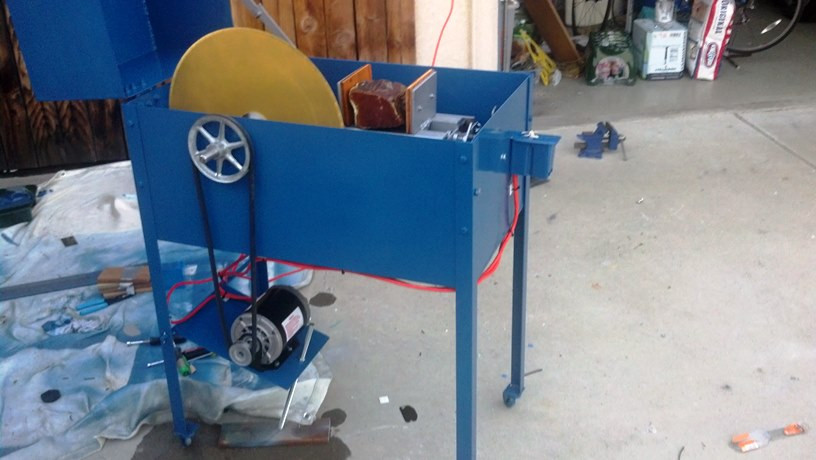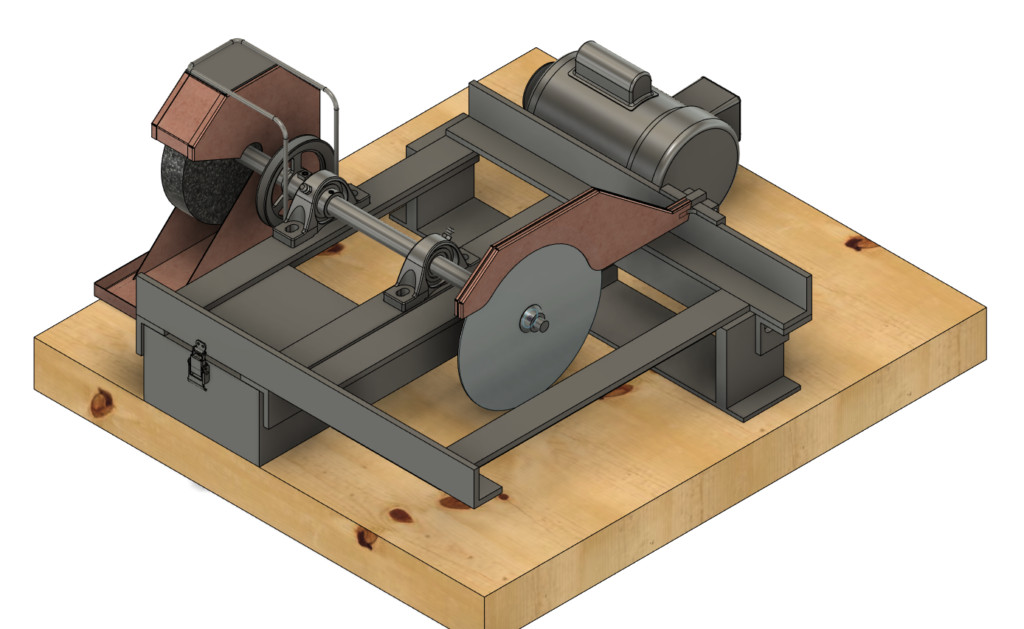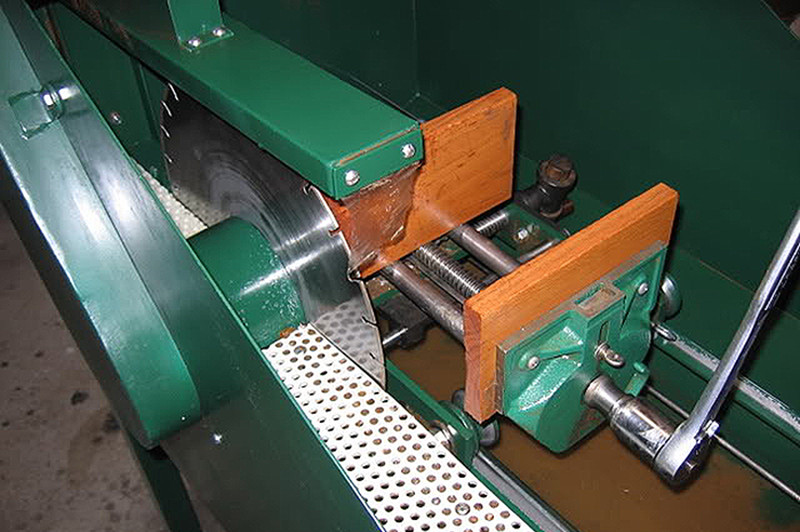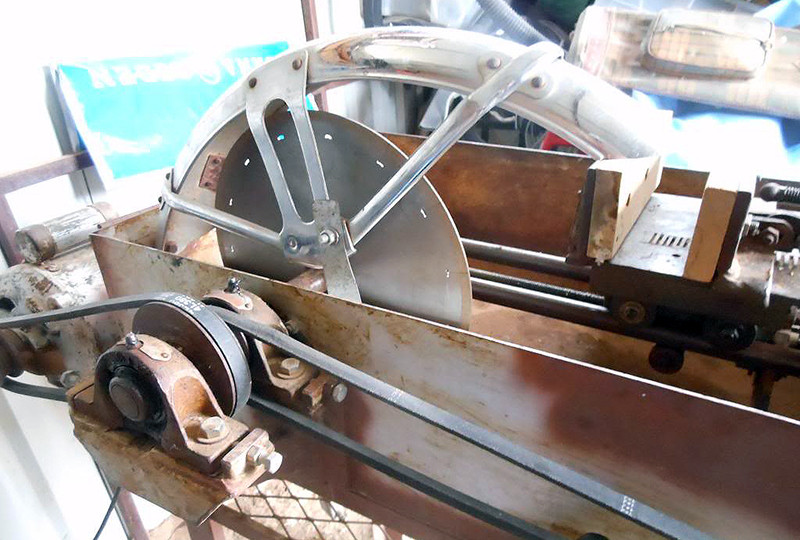Making a rock saw can be a rewarding project for lapidary enthusiasts. Rock saws are essential tools for cutting stones and minerals, and at rockscapes.net, we understand the importance of having the right equipment to bring your creative visions to life. This guide explores various methods for building your own rock saw, offering solutions for hobbyists and professionals alike.
1. Why Build Your Own Rock Saw?
Building your own rock saw offers several advantages. It allows for customization to fit your specific needs, can be more cost-effective than purchasing a commercial model, and provides a deeper understanding of the tool’s mechanics.
- Cost Savings: Commercial rock saws can be expensive, especially larger models. Building your own can significantly reduce costs.
- Customization: Tailor the saw to your specific needs, whether it’s a particular cutting size or specialized features.
- Knowledge: Gain a deeper understanding of how rock saws work, making maintenance and repairs easier.
2. Understanding the Different Types of Rock Saws
Before diving into the building process, it’s essential to understand the different types of rock saws. Each type is designed for specific tasks and materials.
2.1. Slab Saws
Slab saws are designed to cut large rocks into slabs. They typically use a large-diameter blade (10 inches or more) and an oil-based coolant system.
- Purpose: Cutting large rocks into slabs for further processing.
- Blade Size: 10 inches or larger.
- Coolant: Oil-based.
- Mechanism: The rock is fed into the blade, often with an automated system.
2.2. Trim Saws
Trim saws are smaller and used for precise cuts on smaller pieces of rock. They are often used to trim slabs or pre-shaped stones.
- Purpose: Precise cuts on smaller rocks.
- Blade Size: Smaller than slab saws, typically 6-10 inches.
- Coolant: Water-based or oil-based.
- Mechanism: Manual feed, allowing for greater control.
2.3. Tile Saws
While not specifically designed for rocks, tile saws can be adapted for cutting softer stones. They use a diamond blade and a water-based coolant system.
- Purpose: Cutting softer stones and tiles.
- Blade Size: Varies, typically 4-10 inches.
- Coolant: Water-based.
- Mechanism: Manual feed with a sliding table.
2.4. Wire Saws
Wire saws use a thin, abrasive wire to cut through rock. They are particularly useful for cutting intricate shapes and delicate materials.
- Purpose: Cutting intricate shapes and delicate materials.
- Blade: Thin, abrasive wire.
- Coolant: Water-based.
- Mechanism: The wire is drawn through the rock, often with an automated system.
3. Essential Components for Building a Rock Saw
Building a rock saw requires several key components. Understanding these components is crucial for a successful build.
3.1. Motor
The motor provides the power to turn the blade. The size and type of motor will depend on the size of the saw and the materials you plan to cut.
- Horsepower: The required horsepower depends on the blade size and the hardness of the materials. For a small trim saw, a 1/4 to 1/2 HP motor may suffice. For a larger slab saw, you may need a 1 HP or larger motor.
- RPM: The revolutions per minute (RPM) of the motor should be matched to the blade’s recommended speed. Typically, rock saw blades operate at speeds between 1725 and 3450 RPM.
- Type: Both AC and DC motors can be used. AC motors are more common due to their availability and lower cost.
3.2. Blade
The blade is the heart of the rock saw. Diamond blades are the most common type, as they can cut through a wide range of materials.
- Type: Diamond blades are the most versatile and durable.
- Size: The blade size depends on the type of saw and the size of the rocks you plan to cut.
- Arbor Size: Ensure the blade’s arbor size matches the motor’s shaft size.
3.3. Arbor
The arbor is the shaft that connects the blade to the motor. It must be sturdy and precisely aligned to ensure smooth cutting.
- Material: Steel is the most common material for arbors.
- Size: The arbor size must match the blade’s arbor hole and the motor’s shaft size.
- Alignment: Proper alignment is crucial to prevent vibration and ensure accurate cuts.
3.4. Coolant System
A coolant system is essential to keep the blade cool and remove debris from the cutting area. Water or oil-based coolants are typically used.
- Pump: A submersible pump is used to circulate the coolant.
- Reservoir: A container to hold the coolant.
- Nozzle: A nozzle to direct the coolant onto the blade and cutting area.
- Filtration: A system to filter out debris from the coolant, preventing it from recirculating and damaging the blade.
3.5. Frame and Housing
The frame and housing provide support for the motor, blade, and coolant system. They also protect the operator from moving parts and coolant splash.
- Material: Steel, aluminum, or wood can be used for the frame and housing.
- Stability: The frame must be sturdy and stable to prevent vibration.
- Enclosure: The housing should fully enclose the blade and cutting area to protect the operator.
3.6. Vise or Rock Holder
A vise or rock holder is used to secure the rock during cutting. This is particularly important for slab saws, where the rock must be fed into the blade.
- Type: Manual or automatic vises can be used.
- Adjustability: The vise should be adjustable to accommodate different sizes and shapes of rocks.
- Security: The vise must securely hold the rock to prevent movement during cutting.
4. Step-by-Step Guide to Building a Simple Trim Saw
This guide provides a step-by-step approach to building a simple trim saw. It is designed for hobbyists with basic mechanical skills and access to common tools.
4.1. Gathering Materials
Before starting, gather all the necessary materials. This will ensure a smooth building process.
- Motor: 1/4 to 1/2 HP motor with a suitable RPM for your blade.
- Blade: 6-inch diamond blade with the correct arbor size.
- Arbor: Steel arbor to connect the blade to the motor.
- Coolant Pump: Submersible water pump.
- Reservoir: Plastic container to hold the coolant.
- Frame Material: Steel or wood for the frame.
- Housing Material: Plexiglass or sheet metal for the housing.
- Vise: Small vise to hold the rock.
- Hardware: Bolts, nuts, screws, and washers.
- Plumbing: Tubing and fittings for the coolant system.
4.2. Building the Frame
The frame provides the foundation for the saw. It must be sturdy and stable.
- Design: Create a simple frame design using steel or wood. The frame should be large enough to accommodate the motor, blade, and coolant system.
- Cutting: Cut the frame material to the required dimensions.
- Assembly: Assemble the frame using bolts, screws, or welding.
- Stability: Ensure the frame is level and stable.
4.3. Mounting the Motor and Arbor
The motor and arbor must be securely mounted to the frame.
- Motor Mount: Create a mount for the motor on the frame. Ensure the motor is level and securely attached.
- Arbor Installation: Attach the arbor to the motor shaft. Ensure the arbor is properly aligned.
- Blade Attachment: Mount the blade to the arbor. Ensure the blade is securely tightened.
4.4. Creating the Coolant System
The coolant system is essential to keep the blade cool and remove debris.
- Reservoir Placement: Place the coolant reservoir below the blade.
- Pump Installation: Submerge the coolant pump in the reservoir.
- Plumbing: Connect the pump to a nozzle that directs the coolant onto the blade.
- Drainage: Create a system to drain the coolant back into the reservoir.
4.5. Building the Housing
The housing protects the operator from moving parts and coolant splash.
- Design: Create a housing design using plexiglass or sheet metal. The housing should fully enclose the blade and cutting area.
- Cutting: Cut the housing material to the required dimensions.
- Assembly: Assemble the housing using screws or rivets.
- Visibility: Ensure the housing allows for clear visibility of the cutting area.
4.6. Installing the Vise
The vise holds the rock securely during cutting.
- Placement: Mount the vise on the frame near the blade.
- Adjustability: Ensure the vise is adjustable to accommodate different sizes of rocks.
- Security: Ensure the vise securely holds the rock in place.
4.7. Testing and Adjustments
After completing the build, test the saw and make any necessary adjustments.
- Coolant Flow: Check the coolant flow to ensure it adequately cools the blade.
- Blade Alignment: Check the blade alignment to ensure it cuts straight.
- Safety: Ensure all safety features are in place and functioning correctly.
- Adjustments: Make any necessary adjustments to improve performance and safety.
5. Advanced Rock Saw Projects
For experienced builders, advanced rock saw projects offer the opportunity to create highly customized and efficient machines.
5.1. Building a Slab Saw with Automatic Feed
An automatic feed system can greatly improve the efficiency of a slab saw.
- Components: Requires a stepper motor, controller, and linear actuator.
- Mechanism: The stepper motor drives the linear actuator, which slowly feeds the rock into the blade.
- Control: The controller allows for precise adjustment of the feed rate.
5.2. Building a Wire Saw
Wire saws are ideal for cutting intricate shapes and delicate materials.
- Components: Requires a wire spool, tensioning system, and drive mechanism.
- Mechanism: The wire is drawn through the rock, often with an abrasive slurry.
- Control: The tensioning system ensures the wire remains taut during cutting.
5.3. Integrating a Filtration System
A filtration system can extend the life of the coolant and blade by removing debris.
- Components: Requires a filter, pump, and settling tank.
- Mechanism: The coolant is pumped through the filter, which removes debris. The filtered coolant is then returned to the reservoir.
- Maintenance: Regular cleaning and replacement of the filter are required.
6. Safety Considerations
Safety is paramount when building and operating a rock saw. Always take the necessary precautions to prevent accidents.
- Eye Protection: Wear safety glasses to protect your eyes from debris.
- Hand Protection: Wear gloves to protect your hands from sharp edges and coolant.
- Hearing Protection: Wear earplugs or earmuffs to protect your hearing from the noise of the saw.
- Ventilation: Work in a well-ventilated area to avoid inhaling coolant fumes.
- Guards: Ensure all safety guards are in place and functioning correctly.
- Training: Receive proper training on the safe operation of the saw.
7. Troubleshooting Common Issues
Even with careful planning and execution, problems can arise during the building and operation of a rock saw. Here are some common issues and how to address them.
7.1. Blade Vibration
Blade vibration can result in uneven cuts and damage to the blade.
- Cause: Misalignment of the arbor, loose blade, or worn bearings.
- Solution: Check the arbor alignment, tighten the blade, and replace worn bearings.
7.2. Overheating
Overheating can damage the motor and blade.
- Cause: Insufficient coolant flow, overloaded motor, or dull blade.
- Solution: Increase coolant flow, reduce the load on the motor, and sharpen or replace the blade.
7.3. Uneven Cuts
Uneven cuts can result in wasted material and inaccurate slabs.
- Cause: Misalignment of the blade, loose vise, or uneven feed rate.
- Solution: Check the blade alignment, tighten the vise, and ensure a consistent feed rate.
7.4. Coolant Leaks
Coolant leaks can create a mess and waste coolant.
- Cause: Loose fittings, cracked reservoir, or worn seals.
- Solution: Tighten loose fittings, repair or replace the reservoir, and replace worn seals.
8. Maintenance Tips for Longevity
Proper maintenance is essential to keep your rock saw running smoothly and extend its lifespan.
- Regular Cleaning: Clean the saw after each use to remove debris and coolant buildup.
- Lubrication: Lubricate moving parts regularly to prevent wear and tear.
- Coolant Management: Change the coolant regularly and filter it to remove debris.
- Blade Inspection: Inspect the blade regularly for wear and damage.
- Motor Maintenance: Keep the motor clean and properly ventilated.
9. Inspiring DIY Rock Saw Projects
Looking for inspiration? Here are some amazing DIY rock saw projects from the RTH Forum community and beyond.
9.1. Homemade 18″ Slab Saw by Jeff (rsxcram)
Jeff, a long-time RTH member, created a beautiful 18″ slab saw that looks like a professional model. He bought the original plans off eBay and took his time building this awesome machine, resulting in a powerful workhorse saw.
 Homemade 18 inch Slab Saw
Homemade 18 inch Slab Saw
9.2. Homebuilt 10″ Trimsaw/Grinder by farmermac
RTH member farmermac impressed the community with fancy CAD drawings and a build that didn’t disappoint. This 10″ trimsaw/grinder is a testament to precision and craftsmanship.
 Homebuilt 10 inch Trimsaw Grinder
Homebuilt 10 inch Trimsaw Grinder
9.3. Homemade Slab Saw by rockbottom
RTH member rockbottom built a professional-looking 20″ slab saw inspired by Covington’s workhorse rock saw. It features a large viewing pane in the lid and a built-in de-misting system.
 Homemade Slab Saw
Homemade Slab Saw
9.4. Mudshark’s Homemade Slab Saw
Built by RTH member mudshark, this slab saw was frugally pieced together from existing materials and flea market finds, costing under $450.
 Mudshark Homemade Slab Saw
Mudshark Homemade Slab Saw
9.5. Peruano’s Homemade 12″ Slab Saw
Tom (Peruano), a long-time RTH Forum community member, restored this home-built saw. The restoration revealed qualities indicating it was built by a master.
 Peruano Homemade 12 inch Slab Saw
Peruano Homemade 12 inch Slab Saw
These projects showcase the creativity and skill of the DIY lapidary community.
10. Frequently Asked Questions (FAQs)
10.1. What is the best type of blade for a rock saw?
Diamond blades are the most versatile and durable for cutting rocks.
Diamond blades are suitable for a wide range of materials. Their long lifespan makes them a cost-effective choice. You should select the blade size based on the saw type and the size of rocks you plan to cut.
10.2. How much horsepower do I need for a rock saw motor?
The required horsepower depends on the blade size and the hardness of the materials.
For a small trim saw, 1/4 to 1/2 HP may suffice, while larger slab saws may need 1 HP or more. Ensure the motor’s RPM matches the blade’s recommended speed.
10.3. What type of coolant should I use for a rock saw?
Both water-based and oil-based coolants can be used.
Water-based coolants are suitable for softer stones and tile saws. Oil-based coolants are better for larger slab saws and harder materials. Always follow the blade manufacturer’s recommendations.
10.4. How do I prevent my rock saw blade from overheating?
Ensure sufficient coolant flow, avoid overloading the motor, and keep the blade sharp.
Overheating can damage the blade and motor. Regular maintenance and proper usage are essential. Sharp blades cut more efficiently, reducing heat buildup.
10.5. What safety precautions should I take when operating a rock saw?
Always wear eye protection, hand protection, and hearing protection. Work in a well-ventilated area and ensure all safety guards are in place.
Safety is paramount to prevent accidents. Proper training on the safe operation of the saw is crucial. Regular inspection of safety features ensures they function correctly.
10.6. How often should I change the coolant in my rock saw?
Change the coolant regularly, depending on usage and the amount of debris buildup.
Regular coolant changes prevent debris from recirculating and damaging the blade. A filtration system can extend the life of the coolant. Monitor the coolant’s condition and change it when it becomes dirty or contaminated.
10.7. Can I use a tile saw as a rock saw?
Yes, tile saws can be used for cutting softer stones, but they are not ideal for harder materials.
Tile saws use a diamond blade and water-based coolant, making them suitable for softer materials. For harder rocks, a dedicated rock saw with an oil-based coolant is recommended. Consider the saw’s power and blade type before cutting any material.
10.8. How do I align the blade on my rock saw?
Use a straight edge to check the alignment of the blade with the table or vise. Adjust the arbor or motor mount as needed.
Proper alignment prevents uneven cuts and blade vibration. Regular checks ensure the blade remains aligned. Misalignment can cause the blade to wear unevenly, reducing its lifespan.
10.9. What is the best way to secure a rock in the vise?
Ensure the vise is properly adjusted to securely hold the rock without excessive pressure. Use shims if necessary to stabilize irregular shapes.
A secure grip prevents the rock from moving during cutting, ensuring accurate results. Overtightening the vise can damage the rock or the vise itself. Stabilizing irregular shapes with shims provides a more secure hold.
10.10. How do I maintain the motor on my rock saw?
Keep the motor clean and properly ventilated. Lubricate moving parts regularly and check for worn bearings.
Proper motor maintenance extends its lifespan and ensures efficient operation. Regular cleaning prevents dust and debris from causing damage. Lubrication reduces friction and wear on moving parts.
Building your own rock saw can be a fulfilling and cost-effective project. By understanding the different types of saws, essential components, and safety considerations, you can create a machine that meets your specific needs. For more inspiration, detailed guides, and expert advice, visit rockscapes.net.
Ready to start your rock saw project? Explore our resources at rockscapes.net and unleash your creativity! Contact us at Address: 1151 S Forest Ave, Tempe, AZ 85281, United States or Phone: +1 (480) 965-9011.
